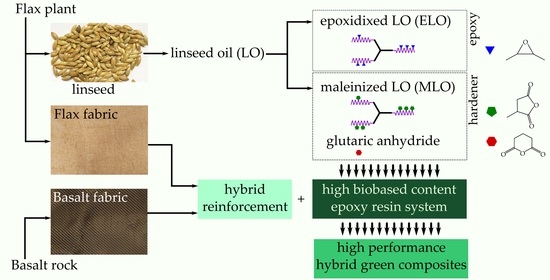Dynamic–Mechanical and Decomposition Properties of Flax/Basalt Hybrid Laminates Based on an Epoxidized Linseed Oil Polymer
Abstract
1. Introduction
2. Materials and Methods
2.1. Materials Selection
2.2. Composite Manufacturing
2.3. Composite Characterization
3. Results and Discussion
4. Conclusions
Author Contributions
Funding
Institutional Review Board Statement
Informed Consent Statement
Data Availability Statement
Conflicts of Interest
References
- Henning, F.; Kärger, L.; Dörr, D.; Schirmaier, F.J.; Seuffert, J.; Bernath, A. Fast Processing and Continuous Simulation of Automotive Structural Composite Components. Compos. Sci. Technol. 2019, 171, 261–279. [Google Scholar] [CrossRef]
- Nagaraj, A.; Rajan, M. Chapter Future Needs and Trends: Influence of Polymers on the Environment. In Polymer Science and Innovative Applications; AlMaadeed, M.A.A., Ponnamma, D., Carignano, M.A., Eds.; Elsevier: Amsterdam, The Netherlands, 2020; pp. 593–634. [Google Scholar]
- Rwahwire, S.; Tomkova, B.; Periyasamy, A.P.; Kale, B.M. Green Thermoset Reinforced Biocomposites. In Green Composites for Automotive Applications; Koronis, G., Silva, A., Eds.; Woodhead Publishing: Sawston, UK, 2019; pp. 61–80. [Google Scholar]
- Radoor, S.; Karayil, J.; Rangappa, M.; Siengchin, S.; Parameswaranpillai, J. A Review on the Extraction of Pineapple, Sisal and Abaca Fibers and Their Use as Reinforcement in Polymer Matrix. eXPRESS Polym. Lett. 2020, 14, 309–335. [Google Scholar] [CrossRef]
- Koronis, G.; Silva, A.; Fontul, M. Green Composites: A Review of Adequate Materials for Automotive Applications. Compos. Part B Eng. 2013, 44, 120–127. [Google Scholar] [CrossRef]
- Amiri, A.; Burkart, V.; Yu, A.; Webster, D.; Ulven, C. The Potential of Natural Composite Materials in Structural Design. In Sustainable Composites for Aerospace Applications; Jawaid, M., Thariq, M., Eds.; Woodhead Publishing: Sawston, UK, 2018; pp. 269–291. [Google Scholar]
- Kawajiri, K.; Kobayashi, M.; Sakamoto, K. Lightweight Materials Equal Lightweight Greenhouse Gas Emissions? A Historical Analysis of Greenhouse Gases of Vehicle Material Substitution. J. Clean. Prod. 2020, 253, 119805. [Google Scholar] [CrossRef]
- Mallick, P.K. Thermoset Matrix Composites for Lightweight Automotive Structures. In Materials, Design and Manufacturing for Lightweight Vehicles, 2nd ed.; Mallick, P.K., Ed.; Woodhead Publishing: Sawston, UK, 2021; pp. 229–263. [Google Scholar]
- Alam, M.; Akram, D.; Sharmin, E.; Zafar, F.; Ahmad, S. Vegetable Oil Based Eco-Friendly Coating Materials: A Review Article. Arab. J. Chem. 2014, 7, 469–479. [Google Scholar] [CrossRef]
- Azwa, Z.N.; Yousif, B.F. Characteristics of Kenaf Fibre/Epoxy Composites Subjected to Thermal Degradation. Polym. Degrad. Stab. 2013, 98, 2752–2759. [Google Scholar] [CrossRef]
- Summerscales, J.; Grove, S. Manufacturing Methods for Natural Fibre Composites. In Natural Fibre Composites; Hodzic, A., Shanks, R., Eds.; Woodhead Publishing: Sawston, UK, 2014; pp. 176–215. [Google Scholar]
- Ramesh, M. Flax (Linum usitatissimum L.) Fibre Reinforced Polymer Composite Materials: A Review on Preparation, Properties and Prospects. Prog. Mater. Sci. 2019, 102, 109–166. [Google Scholar] [CrossRef]
- Sanjay, M.R.; Siengchin, S.; Parameswaranpillai, J.; Jawaid, M.; Pruncu, C.I.; Khan, A. A Comprehensive Review of Techniques for Natural Fibers as Reinforcement in Composites: Preparation, Processing and Characterization. Carbohydr. Polym. 2019, 207, 108–121. [Google Scholar]
- Boquillon, N.; Fringant, C. Polymer Networks Derived from Curing of Epoxidised Linseed Oil: Influence of Different Catalysts and Anhydride Hardeners. Polymers 2000, 41, 8603–8613. [Google Scholar] [CrossRef]
- Ding, C.; Shuttleworth, P.S.; Makin, S.; Clark, J.H.; Matharu, A.S. New Insights into the Curing of Epoxidized Linseed Oil with Dicarboxylic Acids. Green Chem. 2015, 17, 4000–4008. [Google Scholar] [CrossRef]
- Pin, J.-M.; Sbirrazzuoli, N.; Mija, A. From Epoxidized Linseed Oil to Bioresin: An Overall Approach of Epoxy/Anhydride Cross-Linking. ChemSusChem 2015, 8, 1232–1243. [Google Scholar] [CrossRef]
- Baroncini, E.A.; Yadav, S.K.; Palmese, G.R.; Iii, J.F.S. Recent Advances in Bio-Based Epoxy Resins and bio-Based Epoxy Curing Agents. J. Appl. Polym. Sci. 2016, 133. [Google Scholar] [CrossRef]
- Kumar, S.; Samal, S.K.; Mohanty, S.; Nayak, S.K. Epoxidized Soybean Oil-Based Epoxy Blend Cured with Anhydride-Based Cross-Linker: Thermal and Mechanical Characterization. Ind. Eng. Chem. Res. 2017, 56, 687–698. [Google Scholar] [CrossRef]
- Ray, D.; Sain, S. Thermosetting Bioresins as Matrix for Biocomposites. In Biocomposites for High-Performance Applications; Ray, D., Ed.; Woodhead Publishing: Sawston, UK, 2017; pp. 57–80. [Google Scholar]
- Zhang, C.; Garrison, T.F.; Madbouly, S.A.; Kessler, M.R. Recent Advances in Vegetable Oil-Based Polymers and Their Composites. Prog. Polym. Sci. 2017, 71, 91–143. [Google Scholar] [CrossRef]
- Carbonell-Verdu, A.; Ferri, J.; Dominici, F.; Boronat, T.; Sanchez-Nacher, L.; Balart, R.; Torre, L. Manufacturing and Compatibilization of PLA/PBAT Binary Blends by Cottonseed Oil-Based Derivatives. Express Polym. Lett. 2018, 12, 808–823. [Google Scholar] [CrossRef]
- Quiles-Carrillo, L.; Duart, S.; Montanes, N.; Torres-Giner, S.; Balart, R. Enhancement of the Mechanical and Thermal Properties of Injection-Molded Polylactide Parts by the Addition of Acrylated Epoxidized Soybean Oil. Mater. Des. 2018, 140, 54–63. [Google Scholar] [CrossRef]
- Quiles-Carrillo, L.; Blanes-Martínez, M.; Montanes, N.; Fenollar, O.; Torres-Giner, S.; Balart, R. Reactive Toughening of Injection-Molded Polylactide Pieces Using Maleinized Hemp Seed Oil. Eur. Polym. J. 2018, 98, 402–410. [Google Scholar] [CrossRef]
- Quiles-Carrillo, L.; Montanes, N.; Sammon, C.; Balart, R.; Torres-Giner, S. Compatibilization of Highly Sustainable Polylactide/Almond Shell Flour Composites by Reactive Extrusion with Maleinized Linseed Oil. Ind. Crops Prod. 2018, 111, 878–888. [Google Scholar] [CrossRef]
- Ferri, J.; Garcia-Garcia, D.; Sanchez-Nacher, L.; Fenollar, O.; Balart, R. The Effect of Maleinized Linseed Oil (MLO) on Mechanical Performance of Poly(lactic acid)-Thermoplastic Starch (PLA-TPS) Blends. Carbohydr. Polym. 2016, 147, 60–68. [Google Scholar] [CrossRef]
- Ferri, J.M.; Garcia-Garcia, D.; Montanes, N.; Fenollar, O.; Balart, R. The Effect of Maleinized Linseed Oil as Biobased Plasticizer in Poly(lactic acid)-Based Formulations. Polym. Int. 2017, 66, 882–891. [Google Scholar] [CrossRef]
- Carbonell-Verdu, A.; Bernardi, L.; Garcia-Garcia, D.; Sánchez-Nacher, L.; Balart, R. Development of Environmentally Friendly Composite Matrices from Epoxidized Cottonseed Oil. Eur. Polym. J. 2015, 63, 1–10. [Google Scholar] [CrossRef]
- Carbonell-Verdu, A.; Garcia-Garcia, D.; Dominici, F.; Torre, L.; Sanchez-Nacher, L.; Balart, R. PLA Films with Improved Flexibility Properties by Using Maleinized Cottonseed Oil. Eur. Polym. J. 2017, 91, 248–259. [Google Scholar] [CrossRef]
- España, J.M.; Sánchez-Nacher, L.; Boronat, T.; Fombuena, V.; Balart, R. Properties of Biobased Epoxy Resins from Epoxidized Soybean Oil (ESBO) Cured with Maleic Anhydride (MA). J. Am. Oil Chem. Soc. 2012, 89, 2067–2075. [Google Scholar] [CrossRef]
- Fenollar, O.; Garcia-Sanoguera, D.; Sanchez-Nacher, L.; Lopez, J.; Balart, R. Effect of the Epoxidized Linseed Oil Concentration as Natural Plasticizer in Vinyl Plastisols. J. Mater. Sci. 2010, 45, 4406–4413. [Google Scholar] [CrossRef]
- Fombuena, V.; Sanchez-Nacher, L.; Samper, M.D.; Juarez, D.; Balart, R. Study of the Properties of Thermoset Materials Derived from Epoxidized Soybean Oil and Protein Fillers. J. Am. Oil Chem. Soc. 2012, 90, 449–457. [Google Scholar] [CrossRef]
- Thiele, K.; Eversmann, N.; Krombholz, A.; Pufky-Heinrich, D. Bio-Based Epoxy Resins Based on Linseed Oil Cured with Naturally Occurring Acids. Polymers 2019, 11, 1409. [Google Scholar] [CrossRef]
- Muturi, P.; Wang, D.; Dirlikov, S. Epoxidized Vegetable Oils as Reactive Diluents I. Comparison of Vernonia, Epoxidized Soybean and Epoxidized Linseed Oils. Prog. Org. Coat. 1994, 25, 85–94. [Google Scholar] [CrossRef]
- Henna, P.H.; Andjelkovic, D.D.; Kundu, P.P.; LaRock, R.C. Biobased Thermosets from the Free-Radical Copolymerization of Conjugated Linseed Oil. J. Appl. Polym. Sci. 2007, 104, 979–985. [Google Scholar] [CrossRef]
- Samper, M.; Fombuena, V.; Boronat, T.; Garcia-Sanoguera, D.; Balart, R. Thermal and Mechanical Characterization of Epoxy Resins (ELO and ESO) Cured with Anhydrides. J. Am. Oil Chem. Soc. 2012, 89, 1521–1528. [Google Scholar] [CrossRef]
- Lascano, D.; Valcarcel, J.; Balart, R.; Quiles-Carillo, L.; Boronat, T. Manufacturing of Composite Materials with High Environmental Efficiency Using Epoxy Resin of Renewable Origin and Permeable Light Cores for Vaccum-Assited Infusion Molding. InGenius 2020, 62–73. [Google Scholar] [CrossRef]
- Altuna, F.I.; Espósito, L.H.; Ruseckaite, R.A.; Stefani, P.M. Thermal and Mechanical Properties of Anhydride-Cured Epoxy Resins with Different Contents of Biobased Epoxidized Soybean Oil. J. Appl. Polym. Sci. 2011, 120, 789–798. [Google Scholar] [CrossRef]
- Fombuena, V.; Petrucci, R.; Dominici, F.; Jorda-Vilaplana, A.; Montanes, N.; Torre, L. Maleinized Linseed Oil as Epoxy Resin Hardener for Composites with High Bio Content Obtained from Linen Byproducts. Polymers 2019, 11, 301. [Google Scholar] [CrossRef]
- Samper, M.; Petrucci, R.; Sanchez-Nacher, L.; Balart, R.; Kenny, J. New Environmentally Friendly Composite Laminates with Epoxidized Linseed Oil (ELO) and Slate Fiber Fabrics. Compos. Part B Eng. 2015, 71, 203–209. [Google Scholar] [CrossRef]
- ASTM D5023-07. Standard Test Method for Plastics: Dynamic Mechanical Properties: In Flexure (Three-Point Bending); ASTM International: West Conshohocken, PA, USA, 2007. [Google Scholar]
- ISO 11358-1:2014. Plastics—Thermogravimetry (TG) of Polymers—Part 1: General Principles; International Organization for Standardization: Geneva, Switzerland, 2014. [Google Scholar]
- Rohles, C.M.; Gläser, L.; Kohlstedt, M.; Gießelmann, G.; Pearson, S.; Del Campo, A.; Becker, J.; Wittmann, C. A Bio-Based Route to the Carbon-5 Chemical Glutaric Acid and to Bionylon-6,5 Using Metabolically Engineered Corynebacterium glutamicum. Green Chem. 2018, 20, 4662–4674. [Google Scholar] [CrossRef]
- François, C.; Pourchet, S.; Boni, G.; Rautiainen, S.; Samec, J.; Fournier, L.; Robert, C.; Thomas, C.M.; Fontaine, S.; Gaillard, Y.; et al. Design and Synthesis of Biobased Epoxy Thermosets from Biorenewable Resources. Comptes Rendus Chim. 2017, 20, 1006–1016. [Google Scholar] [CrossRef]
- Cardona, F.; Sultan, M.T.B.H.; Abu Talib, A.R.; Ezzah, F.; Derahman, A. Interpenetrating Polymer Network (IPN) with Epoxidized and Acrylated Bioresins and their Composites with Glass and Jute Fibres. BioResources 2016, 11, 11. [Google Scholar] [CrossRef]
- Liu, W.; Xie, T.; Qiu, R. Improvement of Properties for Biobased Composites from Modified Soybean Oil and Hemp Fibers: Dual Role of Diisocyanate. Compos. Part A Appl. Sci. Manuf. 2016, 90, 278–285. [Google Scholar] [CrossRef]
- Monteiro, S.N.; Calado, V.; Rodriguez, R.J.S.; Margem, F.M. Thermogravimetric Behavior of Natural Fibers Reinforced Polymer Composites—An Overview. Mater. Sci. Eng. A 2012, 557, 17–28. [Google Scholar] [CrossRef]
- Richaud, E.; Guinault, A.; Baiz, S.; Nizeyimana, F. Epoxidized Linseed Oils Based Networks. Case of Thermal Degradation. Polym. Degrad. Stab. 2019, 166, 121–134. [Google Scholar] [CrossRef]
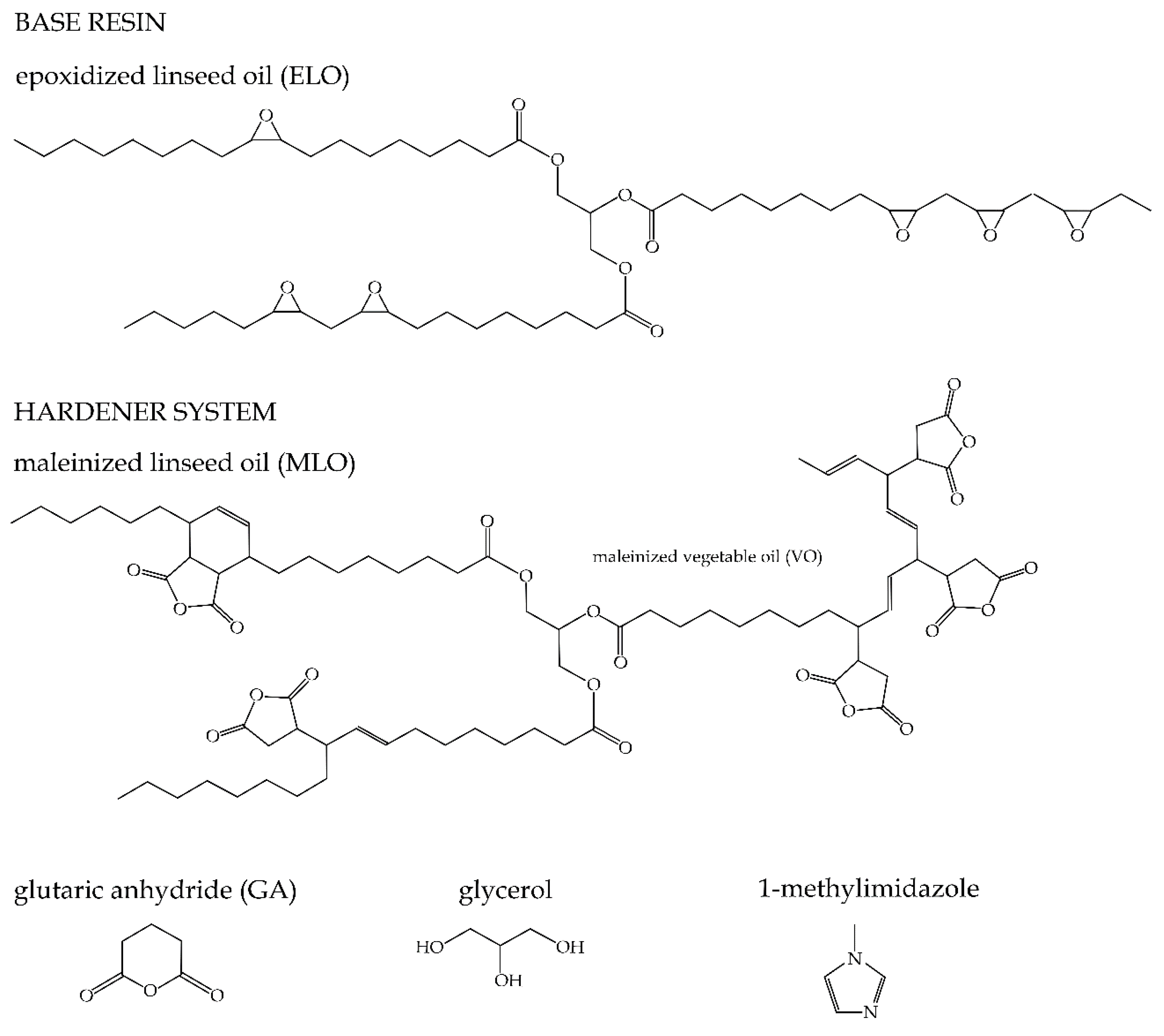
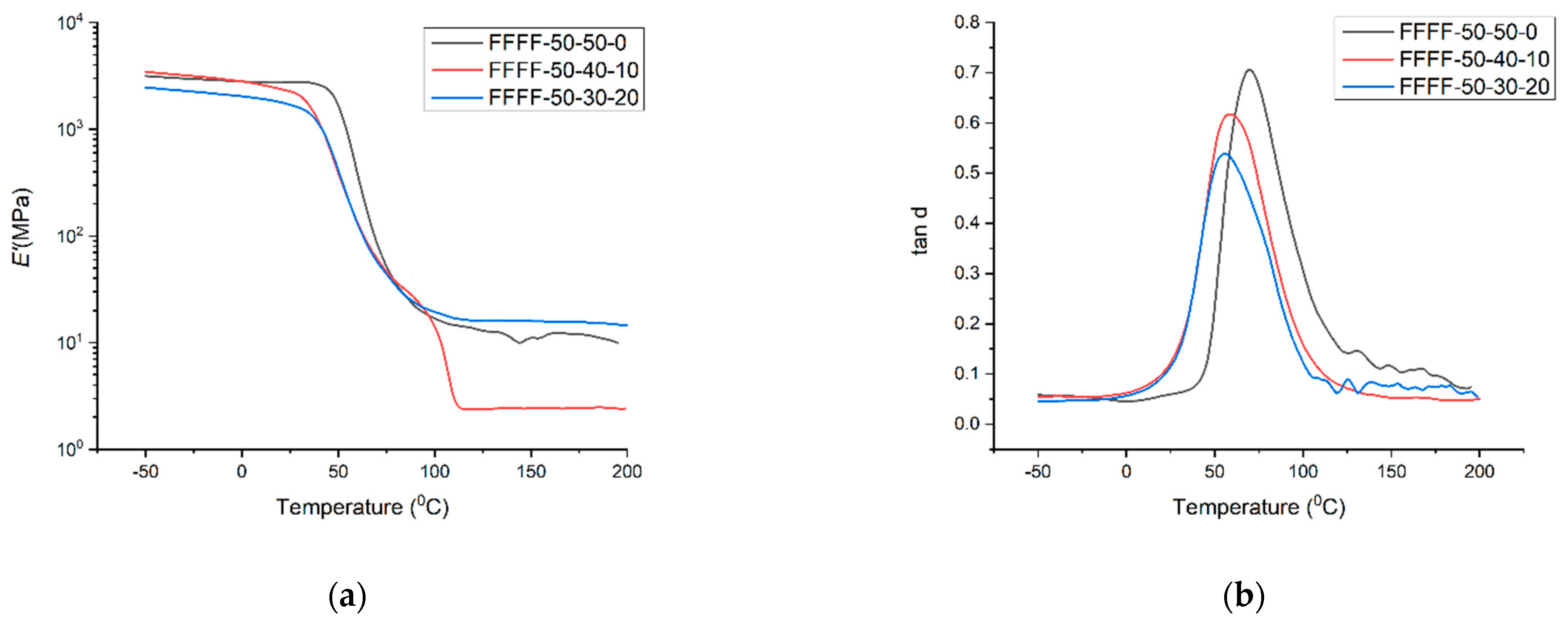
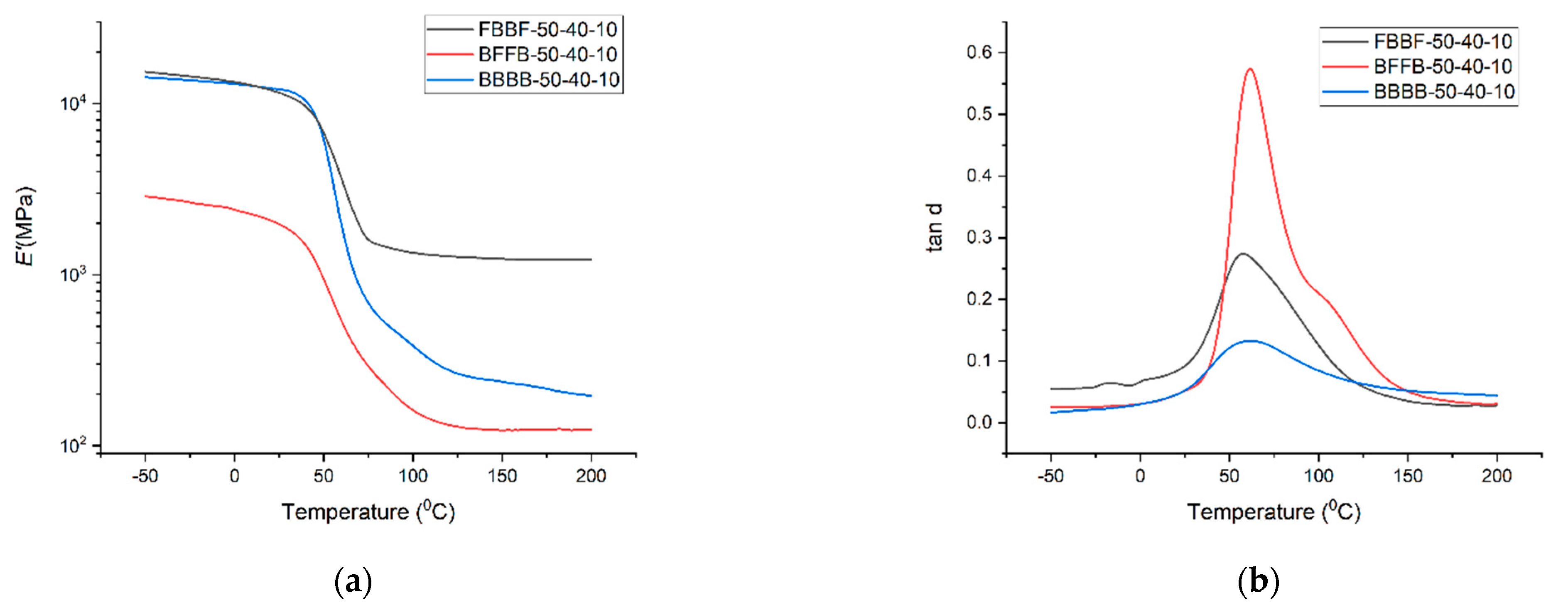
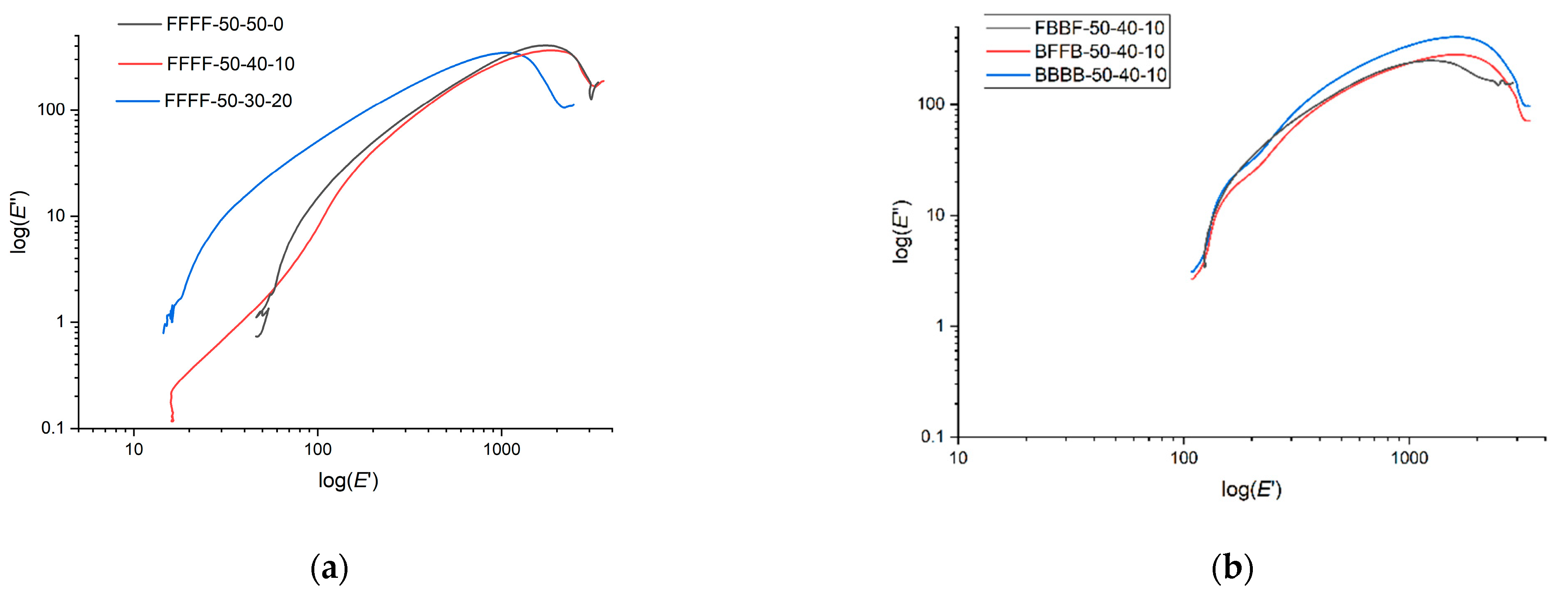

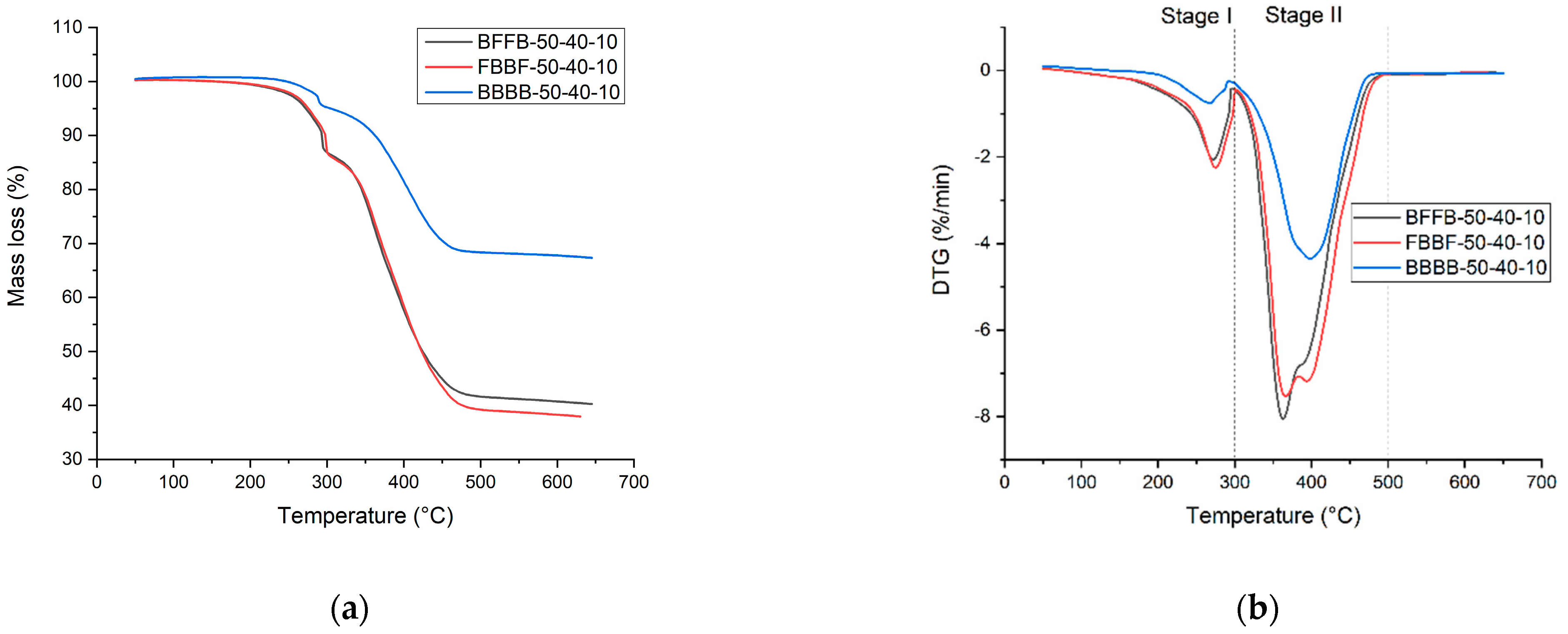
| Sample Architecture | Resin Blend (ELO:GA:MLO) | Tg (°C) | Peak Intensity of tan δ Curve | Crosslinking Density (×103 mol m−3) 1 | Storage Modulus (GPa) 2 |
|---|---|---|---|---|---|
| FFFF | 50:50:0 | 70 | 0.705 | 1.614 | 2.757 |
| 50:40:10 | 59 | 0.617 | 2.120 | 2.268 | |
| 50:30:20 | 56 | 0.538 | 2.054 | 1.954 | |
| FBBF | 50:40:10 | 59 | 0.274 | 15.369 | 2.873 |
| BFFB | 61 | 0.573 | 40.412 | 11.125 | |
| BBBB | 62 | 0.132 | 142.636 | 11.575 |
| Mass Loss Data | FFFF | FBBF | BFFB | BBBB | ||
|---|---|---|---|---|---|---|
| 50:50:0 | 50:40:10 | 50:30:20 | 50:40:10 | |||
| Tonset (°C) | 300.9 | 304.6 | 305.3 | 303.6 | 302.3 | 324.6 |
| Tmid (°C) | 354.3 | 365.3 | 339 | 371.9 | 366.0 | 384.8 |
| Tmax1 (°C) | 266.1 | 269.8 | 268.5 | 270.6 | 272.0 | 267.5 |
| Tmax2 (°C) | 362.4 | 367.6 | 383.2 | 359.2 | 364.1 | 398.2 |
| Tend (°C) | 411.2 | 423.9 | 445.8 | 434.8 | 432.8 | 448.6 |
| Mass change (%) | 82.27 | 81.53 | 79.08 | 58.78 | 56.30 | 51.68 |
| Residual mass (%) | 9.55 (656.4 °C) | 12.07 (653.5 °C) | 15.96 (655.8 °C) | 37.90 (643 °C) | 40.17 (649.8 °C) | 46.85 (675.0 °C) |
| Sample Architecture | Resin Blend (ELO:GA:MLO) | Temperatures at Different Weight Loss (°C) | ||||
|---|---|---|---|---|---|---|
| 5 wt.% | 10 wt.% | 25 wt.% | 50 wt.% | 75 wt.% | ||
| FFFF | 50:50:0 | 247.5 | 268.5 | 314.0 | 363.8 | 427.8 |
| 50:40:10 | 247.5 | 272.5 | 299.4 | 368.1 | 443.7 | |
| 50:30:20 | 250.0 | 277.5 | 333.4 | 374.8 | 427.8 | |
| FBBF | 50:40:10 | 275.0 | 297.5 | 359.7 | 423.3 | - |
| BFFB | 271.5 | 292.5 | 357.2 | 424.4 | - | |
| BBBB | 302.5 | 362.5 | 375.0 | 400 | - | |
Publisher’s Note: MDPI stays neutral with regard to jurisdictional claims in published maps and institutional affiliations. |
© 2021 by the authors. Licensee MDPI, Basel, Switzerland. This article is an open access article distributed under the terms and conditions of the Creative Commons Attribution (CC BY) license (http://creativecommons.org/licenses/by/4.0/).
Share and Cite
Motoc, D.L.; Ferri, J.M.; Ferrandiz-Bou, S.; Garcia-Garcia, D.; Balart, R. Dynamic–Mechanical and Decomposition Properties of Flax/Basalt Hybrid Laminates Based on an Epoxidized Linseed Oil Polymer. Polymers 2021, 13, 479. https://doi.org/10.3390/polym13040479
Motoc DL, Ferri JM, Ferrandiz-Bou S, Garcia-Garcia D, Balart R. Dynamic–Mechanical and Decomposition Properties of Flax/Basalt Hybrid Laminates Based on an Epoxidized Linseed Oil Polymer. Polymers. 2021; 13(4):479. https://doi.org/10.3390/polym13040479
Chicago/Turabian StyleMotoc, Dana Luca, Jose Miguel Ferri, Santiago Ferrandiz-Bou, Daniel Garcia-Garcia, and Rafael Balart. 2021. "Dynamic–Mechanical and Decomposition Properties of Flax/Basalt Hybrid Laminates Based on an Epoxidized Linseed Oil Polymer" Polymers 13, no. 4: 479. https://doi.org/10.3390/polym13040479
APA StyleMotoc, D. L., Ferri, J. M., Ferrandiz-Bou, S., Garcia-Garcia, D., & Balart, R. (2021). Dynamic–Mechanical and Decomposition Properties of Flax/Basalt Hybrid Laminates Based on an Epoxidized Linseed Oil Polymer. Polymers, 13(4), 479. https://doi.org/10.3390/polym13040479







